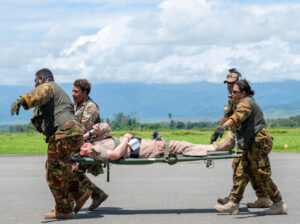
Story by Senior Master Sgt. DeAndre Curtiss
374th Airlift Wing
U.S. Air Force, Royal Australian Air Force and Papua New Guinea Defence Force personnel culminated three days of aeromedical evacuation training and subject matter expert exchanges with a field training exercise during Pacific Angel 24-1 at Port Moresby, Papua New Guinea, August 28, 2024.
U.S. Indo-Pacific Command sponsors Pacific Angel to promote interoperability and demonstrate Department of Defense support capabilities for Humanitarian Assistance and Disaster Response (HA/DR) events by conducting global medical outreach and enhancing regional partnerships. Pacific Angel 24-1 focused on training and equipping PNGDF medical and rescue personnel on tactics and best practices utilized by the U.S. Air Force and Royal Australian Air Force pararescue, combat search and rescue and aeromedical professionals.
“This week we threw a lot at the PNGDF personnel, we started in the classroom introducing them to basic aeromedical evacuation concepts and our various checklists required during each phase of our AE missions,” said U.S. Air Force Capt. Samantha Rose, 18th Aeromedical Evacuation Squadron flight nurse. “It was amazing seeing the PNGDF forces grow from day one of training to the FTX. They improved immensely, not only in their capability but their confidence to conduct AE missions.
The FTX put all of the techniques and procedures that the PNGDF personnel learned throughout the week to test, asking them to access, treat and load simulated casualties onto U.S. Air Force and Royal Australian Air Force aircraft.
“One key takeaway from the whole week is, though we may not usually take patients on flights, the important thing we can take home from this are checking equipment and ensuring every time we come on duty everything is checked and it’s ready,” said Maj. Anna Matthew, PNGDF Health Services, head nurse. “This is really important for me as a health manager because we now have the PAC-750, so we can start working on different SOPs, guidelines and checklists for our nurses for when they conduct medical evacuations.”
To ensure aeromedical evacuation interoperability in the Indo-Pacific theater, PNGDF personnel received training on how to load patients on both the U.S. Air Force HC-130J Combat King II and the Royal Australian Air Force C-27 Sentry. Additionally, PNGDF forces received advice on how to best load their rescue aircraft, the PNGDF PAC 750, which was gifted by the Australian Defence Force. With Australia being a close ally nation, the RAAF works frequently with PNGDF forces.
“The training, I believe, is important for our interoperability. Australia is a neighbor to PNG and there’s the possibility that we might be working together in the future,” said RAAF Flight Lt. Ashley Kennewell, Health Operational Conversion Unit, registered nurse. “This will assist them in laying the foundations for their air medical processes as well. And this is a new thing for them with the PAC-750 so they can take from us the things that have worked for us, the things that have worked for the U.S. Air Force as well, and develop their own policy, procedure, and processes in their air medical evacuations.”
At the conclusion of the FTX PNGDF forces with the assistance of Airmen from the 31st Rescue Squadron, loaded eight simulated patients from three different aircraft onto the HC-130J in Lae and returned back to Port Moresby with not only valuable hands-on experience, but a new confidence in their abilities.
“This is a very good partnership, working and learning from each other, like most of the time we work with what we have, but learning from the US and Australians and seeing practical examples and getting us involved has taught us something we can use for our standard,” said Matthew.
The U.S. military continues to strengthen relationships with allies and partners in the Indo-Pacific through operations such as Pacific Angel to prepare for emergency situations and ultimately to preserve peace and stability throughout the region.